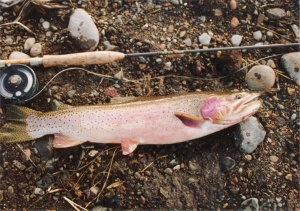No. That’s a story line intended for the media. The reality is more prosaic-
The Idaho Fish and Game Commission has just made a controversial decision to make a big reduction in pelicans at Idaho’s two pelican nesting colonies. They are at Minidoka National Wildlife Refuge on the Snake River and Blackfoot River Reservoir in SE Idaho.
Commission approves 5-year pelican plan
The declining cutthroat trout-
This beautiful trout of many sub-species is the native trout in much of the West. Unfortunately, it is declining almost everywhere, but trout enthusiasts have tried with some success to protect many of the sub-species with the endangered species act and other methods. A petition to list the Yellowstone cutthroat trout was rejected in 2006, but this proposal might reappear.
The Yellowstone Cutthroat lives in the Blackfoot River Reservoir, the Blackfoot River, some of its tributaries and many nearby streams. Unfortunately they are decline because of bad livestock grazing practices, dewatering, the spread of whirling disease, and in SE Idaho the growing leaking of high toxic selenium from the vast open pit phosphate mines into the streams, including the Blackfoot River.
A small percentage is also eaten by the magnificent white pelican, which has been nesting in increasing numbers on two islands in the large, but generally shallow Blackfoot River Reservoir. Most of the pelican take is on the lower 3 miles of the river before it runs into the reservoir. Due to a number of years of low water, this portion of stream has no streamside trees or brush. The pelicans stand in and on the banks of the stream and feast on cutthroat spawners heading upstream and other fish.
If this pelican predation did not occur, the trend for the Yellowstone cutthroat would still be down because of the spread of selenium, and continued grazing abuse.
The growing population of American White Pelican-
The pelican is an imposing bird with a 9-foot wing span. It is also success story, although it is hardly secure. There were over 100,000 breeding pelicans in the Western United States in the early 1900s, but shooting, destruction of habitat, destruction of eggs by predators, including deliberately introduced predators, and finally, thin shelled eggs from DDT and similar pesticides introduced in the 1950s, reduced the population to about 16,000 breeders by the 1970s with no colonies in Idaho.
An inherent threat to pelicans is their habit of nesting in large colonies, so concentrating them and allowing large numbers to be destroyed by disease or whatever all at once. In the early 1900s there were 24 colonies in the West.
Currently the pelican has made a good comeback with about 45,000 breeding birds and 13-15 colonies. Two of the colonies, and they are large ones, are in Idaho. Only Utah and Nevada have more pelicans than Idaho. There were 2390 breeding pelicans at Blackfoot River Reservoir in 2008 (down from 3418 the year before). Minidoka has about 4300 breeding pelicans.
While growing, their population fluctuates in Idaho by as much as 50% a year, and there is evidence the West Nile Virus may be taking an increasing number. I think people should focus as much on the population variability as on mean population.
Pelican and fish-
While a common perception is that pelicans are subsisting on trout, by far their greatest source of food is non-game fish such as Utah Chub, carp, and suckers (over 90% of their food at Blackfoot River Reservoir). Without these non-game fish the pelican colonies would disappear.
Blackfoot Reservoir is stocked each fall with sterile hatchery rainbow trout. These “planters” make up the large majority of trout in the reservoir, not Yellowstone cutthroat trout.
Pelicans forage widely and will travel as far as 80 miles from the nesting site to find fish. In addition to Blackfoot Reservoir, the pelicans have increasingly used the large number of small irrigation reservoirs in SE Idaho, e.g., Alexander, Chesterfield, Daniels, Deep Creek, Twin Lakes, Weston. These are very popular recreational fisheries for local people who visit them to fish for bluegill, bass, and trout (restocked from time-to-time).
These small reservoirs and the planted rainbow at large Blackfoot Reservoir provide a great deal of money for Idaho Fish and Game and a stimulus to the local rural economy.
It is these sport fisheries that have raised hostility to pelicans and are behind popular support to reduce the number of pelicans, not their relatively small predation on the rare Yellowstone cutthroat.
Idaho Fish and Game Department has now received the go-ahead from their bosses at the Commission to cut the pelican population in half with only 700 to be left at Blackfoot Reservoir. This will be done mostly by smearing the eggs with mineral oil rather than direct reduction (killing adult birds).
One of the great dangers in doing is this is the variability of the pelican population which depends on the depth of water at the reservoirs (low water makes for more hatchlings) and factors such as weather and disease. A target of 700 is hard to hit and even harder to maintain.
In summary, once again non-game species like pelicans take a back seat. The ultimate fate of both Yellowstone cutthoat and pelicans depends on people and institutions outside the control of Fish and Game — irrigation users, mining companies, natural artificial disasters.
If you want to see and photograph a large number of pelicans in Idaho, from now through June is probably your last best chance. As far as Yellowstone cutthroat go, their numbers are not going to recover in the Blackfoot River because a new phosphate pit mine is going in (Blackfoot Bridge) and selenium levels in the river are increasing rapidly. Hopefully conservation efforts elsewhere will stabilize and restore this fine native trout.
Previously on this blog :
Rare pelicans to be “managed” (killed) in Idaho
Pelican vs. trout: Idaho F&G’s still out

















